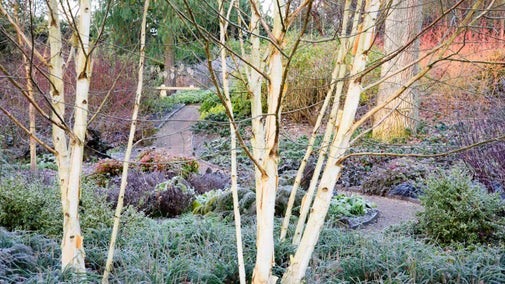
Donate
Everyone needs nature, now more than ever. Donate today and you could help people and nature to thrive at the places we care for.

The team at Mottisfont work very hard to ensure the garden is always looking its best, from delicately pruning hundreds of varieties of roses in the world-class rose garden, to producing huge quantities of our own natural compost every year.
Mottisfont’s gardeners take great pride in looking after the world-class rose garden. The dedicated team lavish care and attention on the National Collection of historic roses.
The gardeners don't tend to deadhead these varieties, which is a surprise to some visitors. Most historic roses flower only once a year, and afterwards produce ornamental fruit or ‘hips' which, as well as brightening the garden in autumn, provide local birds with an important source of winter food.
The team remove the spent blooms of repeat flowering roses by cutting the stem back to a healthy new bud, which will encourage them to keep flowering. It’s during the winter that the gardeners tackle the annual rose pruning; an intense period of work that helps to prepare for spectacular displays in early summer.
At Mottisfont compost-making is integral to keeping the garden, and especially the walled rose garden, in top condition. During the winter we spread more than 60 tonnes of our homemade compost throughout the rose garden and Kitchen Garden.
This will feed the soil, help with water retention, reduce outbreaks of disease and increase the natural production of beneficial fungi. We no longer use fungicide for our roses, focusing instead on natural methods of biosecurity.

As we require very large volumes, we have adopted a rapid system known as ‘hot composting’, which means we can produce usable compost within 4–8 weeks. This way we never let our garden waste build up and we spread out the workload throughout the year.
We are able to do this thanks to a clever machine that grinds and minces our mixed green and brown waste (we generally aim to mix 60 per cent of brown and 40 per cent of green material). A full load in our mixer can make approximately two tonnes of compost – we aim to produce 80 tonnes in a year.
This is then piled to at least 1.2–1.5 metres or shoulder height, which ensures the centre of the pile will heat up to between 50°–70°C. This temperature is ideal for decomposing the mixed waste and killing off any weeds, roots and seed.
We use an industrial cake thermometer to measure the heat in the centre of our pile. As the temperature starts to drop below 50°C, it’s time to turn the compost pile and mix it all again – with our rapid method, this is a weekly task. We turn a small batch by hand but use a small tractor for large quantities.
Our busiest time for making compost is during the autumn, when we harvest almost all of the fallen leaves from hundreds of trees on the estate. We use this leaf harvest to make amazing, fine leaf compost, perfect to make our soil and plants thrive. We even use it as peat-free potting compost.
As well as enjoying the colourful, seasonal displays from the trees, you can help contribute to our garden compost. Who doesn't love gathering big handfuls of crunchy autumn leaves? You'll find leaf bins dotted around the north and south paddocks – just add your harvest to help ours.

Everyone needs nature, now more than ever. Donate today and you could help people and nature to thrive at the places we care for.
Enjoy every season at Mottisfont, with its ancient trees and babbling brooks, from rich autumn foliage and the scented Winter Garden to snowdrops, the first harbingers of spring and, of course, the world-famous Rose Garden.

The National Collection of Pre-1900 Shrub Roses reaches its peak flowering season in early summer for a spectacular annual display.

Our work managing Mottisfont’s river and woodlands aims to create a wildlife-rich habitat, find out more about how we care for the estate.

We’re doing lots of work to look after the countryside sites of Stockbridge Down, Stockbridge Marsh and Curbridge Nature Reserve in order to provide key habitats for rare species.

Find out how you could join us - whether you're looking to make new friends, develop skills or simply want to be part of something you're passionate about.

Mottisfont offers a fantastic family day out, with something for everyone. As well as the wild play area, scenic river and meadow, there are specially-designed activities for pre-schoolers and exciting events every school holiday. Enjoy perfect winter picnic spots, delicious treats from our cafés, and convenient baby-changing facilities - all in a beautiful, welcoming environment.

We believe that nature, beauty and history are for everyone. That’s why we’re supporting wildlife, protecting historic sites and more. Find out about our work.

Follow these simple steps to make your own nutrient-packed compost at home. Learn about the qualities of good compost and find out top tips, including how to turn your heap and build your compost beds.
